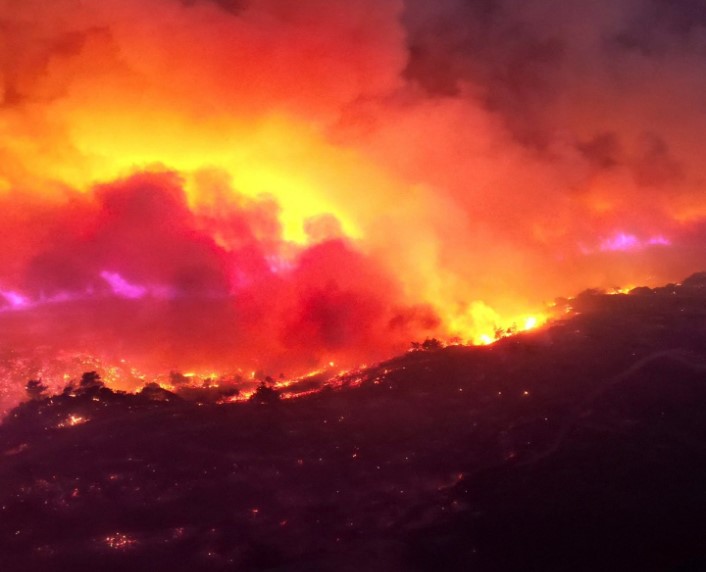The fire situation in Greece is increasingly dramatic. Firefighters are struggling to contain 82 blazes across the country. 64 of which started yesterday, so far the hottest day of the summer.
In addition to the vast fire ravaging the island of Rhodes, which has forced 19,000 people to flee, flames have also broken out on the island of Corfu. There, 17 villages have been evacuated. And, the Coast Guard has rescued 59 people who were on the beach in Nisaki.
Table of Contents
Dramatic wildfires in Rhodes
According to the mayor of Corfu, Giorgos Mahimaris, the flames that broke out on Mount Pantokratoras are of an ‘arson nature’.
Residents and tourists who were evacuated for safety reasons were taken to the Agios Markos stadium and the Municipal Theatre of Corfu, the first citizen told the state news agency Apa-Mpa. Two helicopters and two fire brigade planes are working to extinguish the fire, Mahimaris added.
In Evia, authorities told residents of four southern villages to evacuate to the town of Karystos, west of where the fire was advancing. Central Greece’s deputy governor Giorgos Kelaiditis, who was near one of the villages, told state agency Ana-Mpa that the situation is difficult. “The fire may be 2km away. But the wind is strong, the smoke thick and the air is hard to breathe,” he said.
Other wildfires in Greece
More fires broke out in the northern region of the Peloponnese, near the town of Aigio. Traffic on the old Athens-Patras highway, which crosses the coast, was disrupted.
Shortly before midnight yesterday, the authorities called for further evacuations from Corfu and the northern Peloponnese. In the case of Corfu, they said that the fire was ‘moving south-eastwards on a wide front’. And added that private ships were ready to collect evacuees.
A fire broke out west of the archaeological site of Epidaurus, firefighters said. The Ministry of Climate Change and Civil Protection said the emergency in Rhodes triggered ‘the largest fire evacuation in the country’.
Read also: Heat wave over the Earth’s northern hemisphere: scorching weather over Europe, China and the US
Why Europe is burning the most
A 2022 study in Nature sought to explain why, even though the temperature has risen by 1.1 degrees Celsius worldwide, it is Europe that is the continent most affected by the devastating effects of increased heat.
Specifically, over the past 42 years, Europe has become three to four times more prone to heat waves than the rest of the mid-latitudes of the northern hemisphere. The research showed that low atmospheric pressure air in southern Europe draws warm Saharan air northwards.
According to the researchers, extreme warm weather events have increased in frequency and intensity over the past four decades in southern and western Europe due to jet streams at mid-latitudes. The jet stream is a river of fast winds that flows mainly from west to east. And is formed by differences in temperature and pressure of air masses.
Rising temperatures have caused the temperature contrast that drives the jet stream to decrease, making the currents slower and weaker. Warm air masses develop in weak winds, and the slower the current, the longer even extreme atmospheric events will last.
In particular, the jet stream flowing in Europe is not only slowed down. But it is also split. And this factor increases extreme heatwaves, but it is not yet clear what causes the current to split in two.
Read also: The Mediterranean Sea is increasingly at risk: CO2 has risen by 15% in the last quarter century












